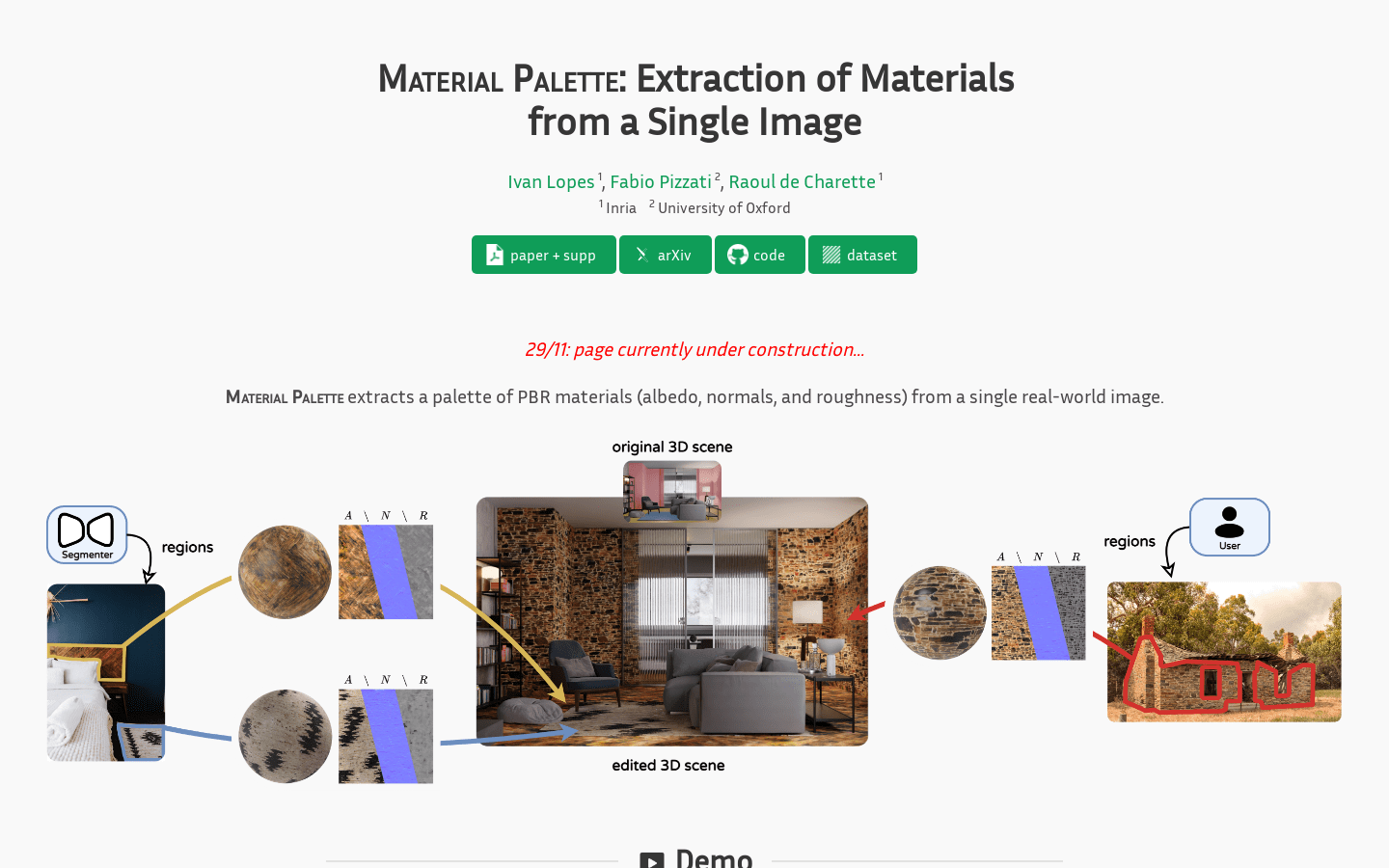










Material Palette
Material Palette:'Material extraction from image.'
Tags:AI image generationAI image editing AI image generation Material extraction Open Source PBR materials Rendering applications Standard Picks Texture generation Unsupervised domain adaptationOverview
The Material Palette tool represents a significant advancement in material extraction and texture generation from real-world imagery. It introduces an innovative approach to extract physically-based rendering (PBR) materials, including albedo, normal maps, and roughness values, directly from single-source images. This system employs a sophisticated diffusion model to map specific regions of input images to corresponding material attributes, enabling the synthesis of highly realistic texture samples that closely mimic materials observed in similar contexts.
Beyond mere texture generation, Material Palette incorporates an independent neural network capable of decomposing these generated textures into spatially-varying bidirectional reflectance distribution functions (SVBRDF). This decomposition step is critical as it transforms static texture data into dynamic, usable materials for rendering applications. By leveraging a comprehensive synthetic material library and a extensive dataset of diffusion-generated RGB textures, the system achieves robust generalization through unsupervised domain adaptation techniques.
The tool has undergone rigorous evaluation using both synthetic and real-world datasets, demonstrating its effectiveness in estimating PBR materials from real photographs. Its primary application lies in enhancing 3D scene editing by providing accurate material estimates derived from real-world imagery. This capability makes it an invaluable asset for creating realistic virtual environments and speeding up the production process in various industries.
Target Users
Material Palette is designed for users involved in 3D content creation, rendering, and simulation. Its primary audience includes:
– Game developers seeking to create realistic textures from reference images
– Visual effects artists aiming to streamline material extraction processes
– Researchers exploring advancements in PBR and neural rendering techniques
– Architects and designers working on photorealistic visualizations
Use Cases
The tool offers versatile applications across multiple domains. Key use cases include:
1. **Material Extraction from Real Photos**: Extract detailed PBR materials directly from reference images for use in 3D models.
2. **Enhanced 3D Scene Editing**: Use the extracted materials to populate and enhance virtual environments with realistic textures and properties.
3. **Realistic Rendering**: Apply the generated SVBRDF data to achieve more accurate material behaviors under varying lighting conditions.
4. **Efficient Asset Creation**: Streamline the process of creating high-quality materials by leveraging real-world references.
Features
The Material Palette tool offers a comprehensive suite of features:
1. **Single-Image Material Extraction**: Capable of extracting full PBR material palettes from a single reference image.
2. **Region-to-Material Mapping**: Advanced diffusion model mapping that associates specific image regions with corresponding material attributes.
3. **Texture Synthesis**: Generates high-quality texture samples that match the appearance and properties of real materials.
4. **SVBRDF Decomposition**: Breaks down textures into spatially-varying BRDF parameters for realistic rendering applications.
5. **Unsupervised Domain Adaptation**: Enables generalization across different domains without requiring extensive labeled data.
6. **3D Scene Editing Support**: Provides tools and outputs specifically designed to facilitate 3D scene modification and enhancement.
7. **Comprehensive Evaluation**: Backed by thorough testing on diverse datasets, ensuring robust performance across various scenarios.
By combining these advanced features, Material Palette represents a powerful solution for anyone looking to bring real-world materials into their 3D projects with unprecedented accuracy and efficiency.
























